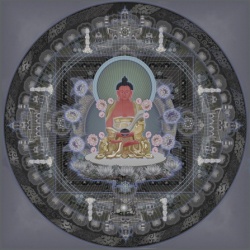Difference between revisions of "Dharmata"
| Line 27: | Line 27: | ||
[[absolute nature]] | [[absolute nature]] | ||
| − | [[intrinsic nature | + | [[intrinsic nature of reality]] |
[[intrinsic reality]] | [[intrinsic reality]] | ||
Revision as of 04:04, 22 October 2015
Dharmata (Tib. ཆོས་ཉིད་; chos nyid).
The innate nature of phenomena and mind. dharmata (zhenrú, cho nyi):
Phenomena as it really is or as seen by a completely enlightened being without any distortion or obscuration.
True or absolute reality.” Often translated as “true suchness” or the “true nature of things.”
See also; “bhuta-tathata” and “Distinguishing Dharma and Dharmata.”
Dharmata (Skt. dharmatā; Tib. ཆོས་ཉིད་, chönyi; Wyl. chos nyid) — suchness, or the true nature of reality.
Sogyal Rinpoche writes:
The Sanskrit word dharmatā, ཆོས་ཉིད་, chö nyi in Tibetan, means the intrinsic nature of everything, the essence of things as they are. Dharmata is the naked, unconditioned truth, the nature of reality, or the true nature of phenomenal existence.[1]
Notes
Sogyal Rinpoche, The Tibetan Book of Living and Dying, revised and updated edition (Harper San Francisco, 2002), pages 278-279.
Alternative Translations
absolute nature
intrinsic nature of reality
intrinsic reality
see also; Tathatā
